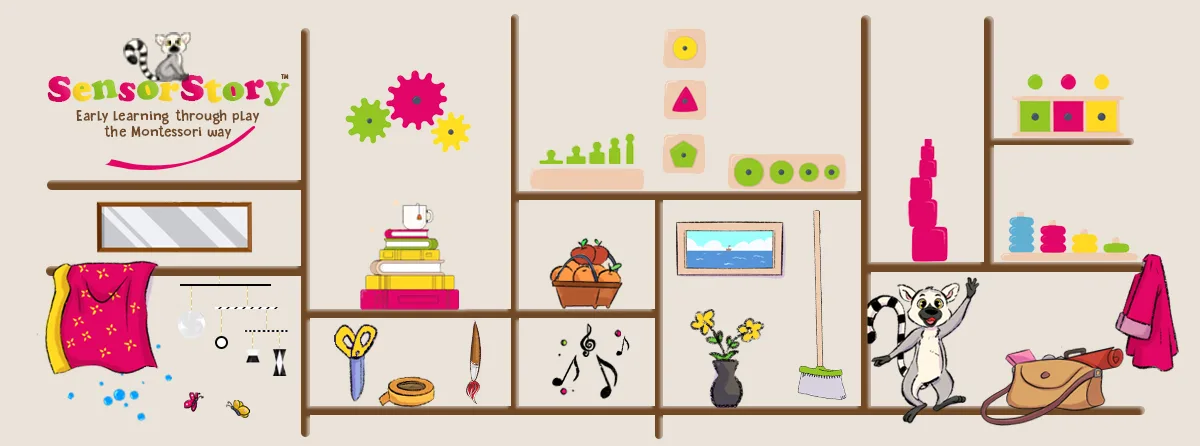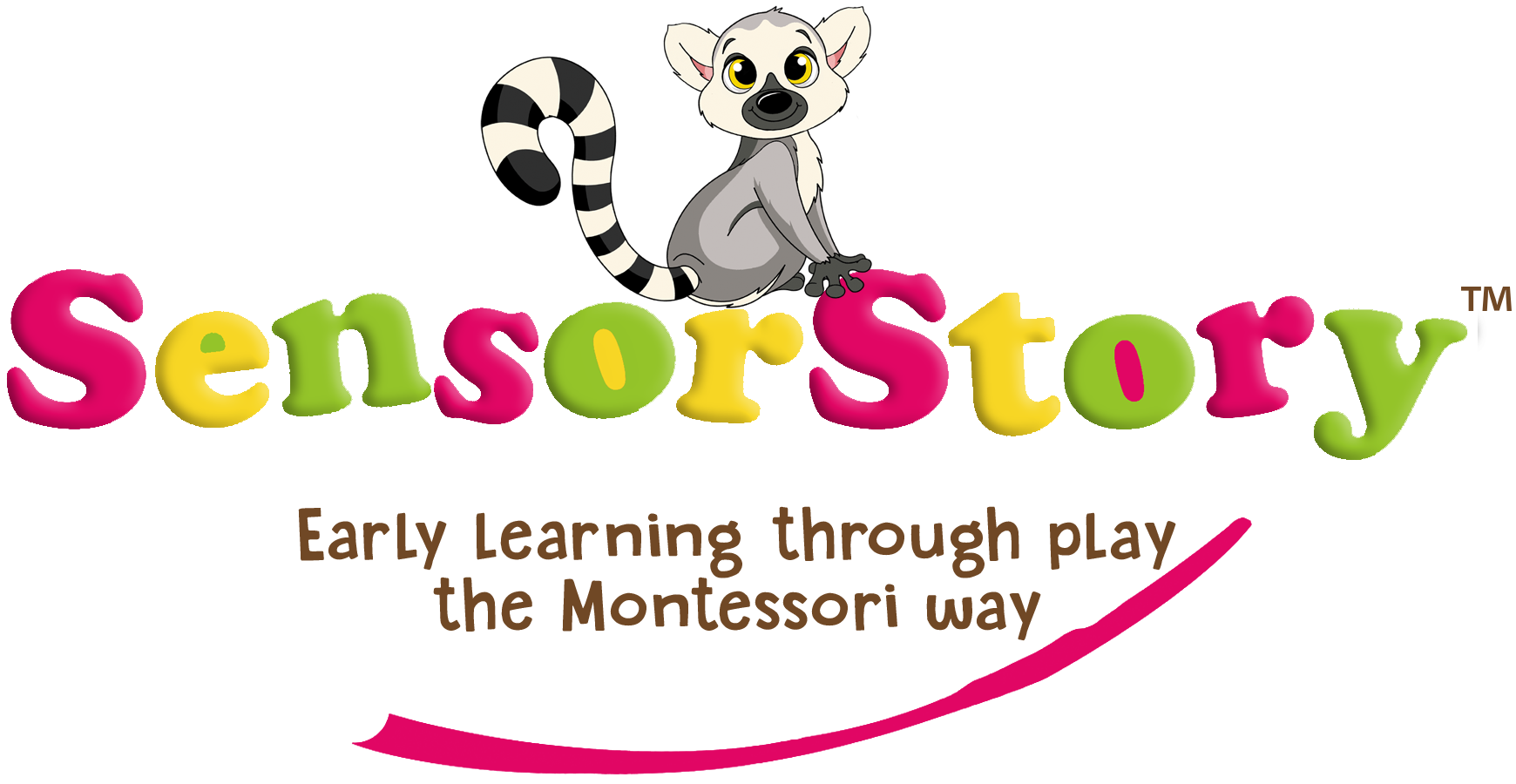We've put together a detailed list of at-home Montessori-aligned activities suitable for a 8-month-old.
Here you will see age-appropriate activities for all areas, in our Ultimate Series Of Activities to try at home, where the emphasis is on providing a prepared environment and allowing the child to actively engage in self-directed learning.
So what is my child working on mastering at this age?
Between the 6-9 month age, your baby's focus is on further developing sensorimotor skills. Your child is likely working on refining motor skills, such as sitting up and exploring the environment through crawling. Fine motor skills, like grasping objects, become more coordinated. Language development continues with exposure to speech and sound, and your baby is encouraged to engage in babbling. Independence is fostered through simple tasks, and a sense of order in the environment is introduced to provide security and predictability.

1. Sensory Exploration:
* Introduce sensory bottles: clear plastic bottles filled with coloured water or other visually interesting materials, including items like glitter, small beads, or rice for visual and auditory stimulation.
* Offer edible sensory materials, such as cooked pasta or soft fruits to explore textures and tastes.
* Encourage water play with a shallow basin, allowing the baby to splash and feel different temperatures.
* Nature exploration with a focus on different textures like grass, sand, or tree bark.
* Create sensory freezer bags filled coloured hair gel, or soft beads, encouraging baby to press and explore the sensory materials within the bags.
* Make or purchase edible playdough with natural scents. Allow baby to explore and manipulate the playdough.
* Provide a sensory bin: a shallow container filled with soft, sensory-rich materials like rice or pasta. Hide objects for baby to discover through touch.
2. Eye-Hand Coordination:
* Introduce a set of large, lightweight building blocks for stacking and knocking down.
* Offer soft, squeezable toys for your baby to grasp and explore.
* Introduce a set of large, lightweight blocks for baby to hold and explore, promoting fine motor skills.
* Provide a teething toy for mouthing and tactile exploration.
* Provide soft, lightweight rattles with handles for baby to hold and shake.
* Introduce soft puzzles with large, easy-to-grasp pieces that baby can manipulate.
* Allow baby to engage in safe and edible finger painting, promoting fine motor skills.
* Provide soft containers with easy-to-open lids for your baby to explore and manipulate.
3. Gross Motor Skills:
* Introduce a soft, oversized ball for baby to roll and crawl after.
* Set up a safe, padded crawling area with blankets and cushions for exploration.
* Encourage reaching and grabbing for hanging toys.
* Offer a large spinning top that moves when pressed.
* Introduce a soft, plush ball for the baby to roll and explore.
* Low, soft steps or ramps: Introduce low steps or ramps to encourage gentle climbing movements.
* Create simple sensory paths with soft materials or fabrics for your baby to explore with their hands and feet.
* Provide a Montessori balance board for baby to practice shifting weight.
* Hold your baby and sway gently to music, encouraging rhythm and movement.
4. Practical Life Skills:
* Allow baby to hold and drink from a baby-sized cup.
* Provide a small bowl and a soft spoon for your baby to explore scooping and transferring.
* Introduce a soft cloth for baby to explore after nappy changes or after meals.
* Offer a soft baby hairbrush for baby to explore and model how to brush your hair.
* Encourage baby to practice opening and closing soft containers with easy-to-manipulate lids.
* Offer soft, squeezable toys to encourage hand strength and coordination.
5. Language Development:
* Multisensory storytelling: engage in soft, multisensory rhythmic storytelling during quiet moments.
* Engage in Baby Sign Language with your baby. To learn more about using Baby Sign Langauge click here.
* Read soft, cloth or board books with simple photos or beautiful illustations.
* Engage in conversations with your baby, narrating what you are doing or describing what they are seeing, to help them develop their listening and communication skills.
* Introduce soft animal toys introducing basic vocabulary through play.
* Sing gentle nursery rhymes and lullabies, introducing your baby to rhythmic patterns and melodic sounds.
6. Art Exploration:
* Create simple stamps using baby-safe materials like soft sponges or textured fabrics, encourage baby to press the stamps onto paper to explore patterns and textures.
* Offer non-toxic, washable finger paints for baby to explore colour and texture.
* Introduce large, easy-to-grip crayons for the baby to explore mark-making on paper.
* Allow baby to crumple and tear paper for a tactile experience.
* Add a small amount of paint to a sealable freezer bag and securely seal it. Allow baby to squish and move the paint around inside the bag.
* Create DIY sensory paints using safe ingredients like pudding or yogurt mixed with natural food colouring.
7. Music:
* Create sealed bottles with soft chimes inside, allowing baby to explore the sound through movement.
* Sing songs with repetitive actions, encouraging baby to mimic movements like clapping or waving.
* Provide a gentle, wind-up music box that plays soothing tunes.
* Introduce small musical instruments like a soft drum or xylophone.
* Soft sound exploration baskets: fill a basket with soft materials that produce gentle sounds when touched or manipulated.
* Provide a set of soft rattles for your baby to shake and explore different sounds.
* Hang a wind chime in gentle breeze to allow baby to experience soft, melodic tones.
8. Nature Exploration:
* Create a nature-inspired sensory basket with safe items like pinecones, leaves, or fabric.
* Introduce wooden animal figures for gentle play and exploration.
* Soft outdoor blanket: use a soft blanket for outdoor play and relaxation.
* Encourgae your baby to feel grass or leaves during outdoor play.
9. Object Permanence:
* Introduce nesting cups or containers for baby to explore opening and closing lids.
* Place a soft cloth over a toy and encourage baby to reveal it.
* Introduce soft books with fabric flaps that your baby can lift to reveal hidden pictures or objects.
* Place a soft toy inside a cloth bag and allow baby to explore reaching inside to retrieve it.
* Create a simple pop-up tent using soft fabric, allowing baby to enter and exit, experiencing moments of disappearance and reappearance.
10. Social Interaction:
* Arrange playdates with other babies for social engagement.
* Engage in interactive games, such as gentle clapping or patty-cake.
* Encourage mirrored play by imitating baby's expressions and sounds.
11. The Whole Child Development:
* Attend our weekly SensorStory Baby and Toddler Montessori parent-child sensory classes! Follow this link to enrol your infant here.
We hope we have given you some inpiration for activities to do with your 8-month-old!
Remember, follow the child, adapting activities based on your observation of your baby's developmental stage and individual interests. The key in a Montessori environment is to provide your child with real, purposeful, and age-appropriate tools and materials that allow them to engage in activities independently and at their own pace.
Disclaimer: Adult supervision is required for any activity suggested by SensorStory. Please follow any directions and/or warnings on the labels(s) of any materials used during such activity & be aware of any potential choking hazards or allergies.
Click here to see our
Activities To Do With A 9 Month Old
FAQ.
